By Craig Murray
in the Bekaa Valley, Lebanon
CraigMurray.org.uk
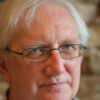 On Thursday evening news came through that we had at long last gained the full list of approvals required to travel to report outside Beirut; we were cleared by the Ministry of Information, the Ministry of Defence, and the local authorities.
On Thursday evening news came through that we had at long last gained the full list of approvals required to travel to report outside Beirut; we were cleared by the Ministry of Information, the Ministry of Defence, and the local authorities.
Laith Marouf of Free Palestine TV called me and suggested we go down together on Friday to the southern capital of Nabatieh, which has been enduring heavy bombing.
I asked Laith to give me half an hour, and did some quick research. Nabatieh is about 12 miles from the Israeli border and has been devastated by Israeli bombing attacks. In the South of the country some 70,000 homes have been destroyed.
Following the Gaza model, hospitals, schools, mosques, waterworks, churches, bakeries have all been systematically taken out. In brief occupations Israel has demolished entire villages.
Israel has also deliberately destroyed the crops and livestock.
I read this brilliant article by Hanna Davis for Middle East Eye 10 days earlier, which describes Nabatieh in apocalyptic terms. It is centred on interviews with the heroic civil defence workers, who are especially targeted by Israel.
“Back at the hilltop, Fakih’s colleagues also spoke about the immense stress and psychological pressure they were under.
‘Mentally, we are all struggling,’ Hussein Jaber, 30, from Nabatieh’s civil defence, told MEE.
‘We are struggling with the lack of stability. We are always on the move, can’t sleep well, and are being put in intense situations,’ he said.
‘We have to pull out the dead bodies of people we love, friends and families we know, neighbours, people from our own area.’”
Since then, the situation had deteriorated even further. A hundred people had been reported dead in Nabatieh in a fresh wave of airstrikes the day before.
It had not been exactly safe in Beirut since I had arrived, but now Laith had faced me with the inevitable question. Did I really have the courage to do what I had come to Lebanon in order to do? That is why I had asked for half an hour to research and think it over.
Well, I phoned Laith back and asked him what time we could start.
Laith is good company. A lifelong activist, he has been hounded and demonised by Zionists his entire career, which has centred on attempting to establish independent broadcasting platforms. He is currently trying to grow Free Palestine TV into a serious operation, and is full of cheerful facts about the relative reach of online and broadcast media. I do hope he succeeds.
The next morning Niels [Ladefoged] gathered his equipment and I took a spare jacket and tie, in case my suit got dusty. Laith arrived with his cinematographer, the debonaire and intrepid Hadi Hotait, driving.
Hadi’s car is a capacious SUV from which all signs of branding fell off many years ago, along with many other superfluous pieces. He appeared to have an entire film studio packed in the back. I should not have been surprised if, on arrival, a couple of extras had appeared from under the unfathomable mound.
Hadi navigated his way through the backstreets of Beirut between cars triple-parked so badly it seemed a physical impossibility to get between them. Hadi overcame this by the simple expedient of going very fast. I think his old car, like the DeLorean in Back to the Future, enters a different dimension at sufficient speed. I cannot imagine how else he did it.
While I was contemplating that the Israelis might not be as likely to kill me as Hadi’s driving, Laith blithely announced we were not going to Nabatieh after all. The bombing there was so intense this morning that the army had closed the road. We were therefore going to Baalbek instead.
I knew that 60 people had been killed in bombing the day before there. I hated to think what was happening in Nabatieh if it is more dangerous than Baalbek. But on the other hand I had long wanted to go to Baalbek and to see the famed Bekaa Valley, so I was quite pleased.
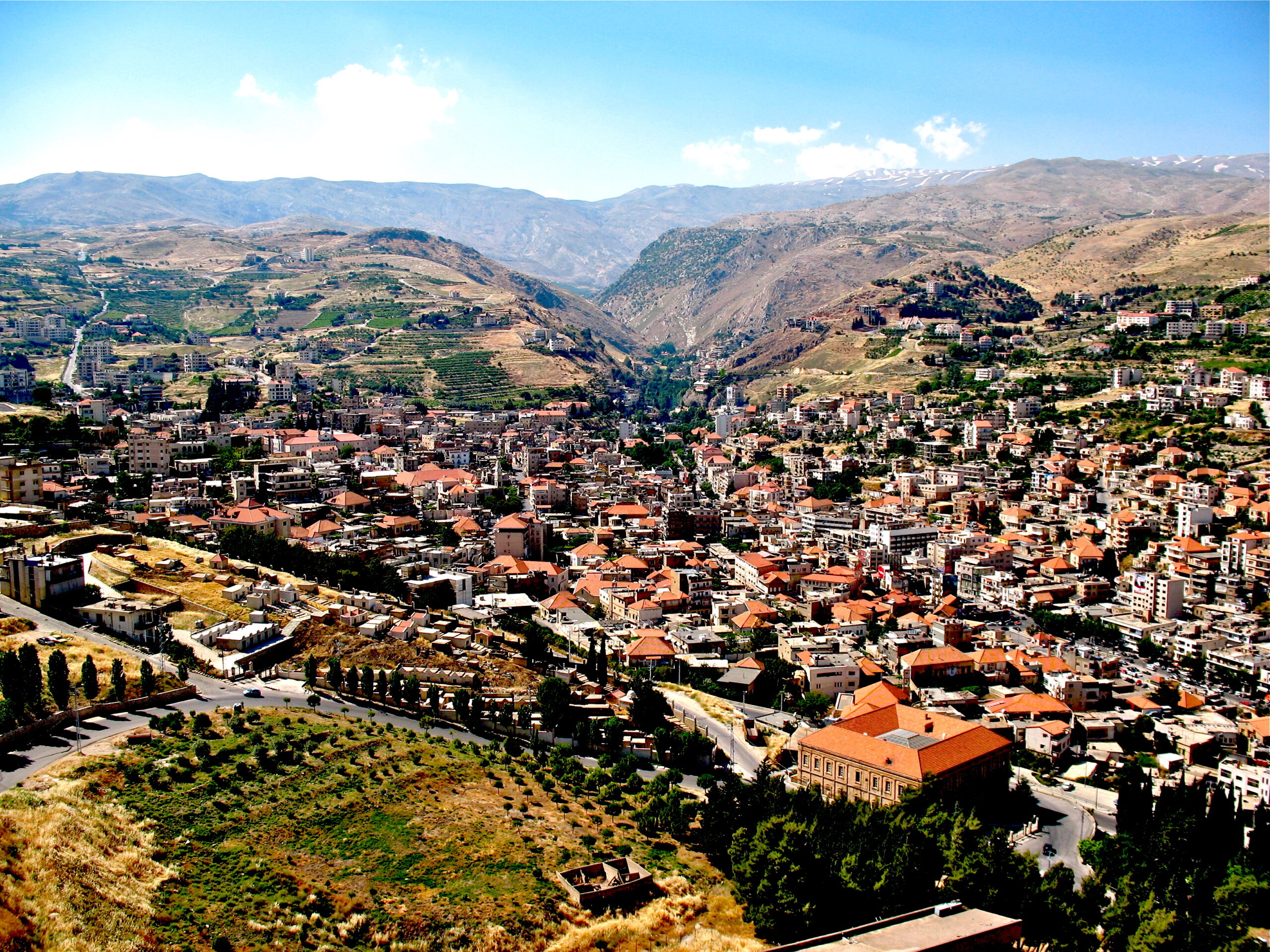
Zahlé, capital of the Beqaa Governorate in Lebanon. (Nassif, Wikimedia Commons, Public domain)
We chatted away as we climbed the steep ascent of the slopes of Mount Lebanon. Hadi’s ancient car was somehow texting warning messages to his phone: “transmission overheating,” “check fluid levels.” At one stage an old Scotsman popped his head out of all the equipment in the back and said “Captain, the warp drive is not stable.” Although I may have nodded off and dreamt that.
Hadi emerged as a driver of incredible speed and skill, though whether it was an entirely appropriate way to proceed when not on a racetrack might be open to debate. Anyway, we managed only to crash once before we reached the top of the pass and the Bekaa Valley spread out below us like a beautifully worked carpet.
What surprised me was how close it all is. We were only 30 minutes outside of Beirut, and there to my right I could see the Israeli occupied Golan Heights. Straight ahead were the mountain ranges where Hezbollah had defeated Isis.
We were on the spot of the defining 1982 battle where the Syrian Army and Iranian-reinforced Palestinians heroically blocked the Israeli advance. Heading to our left, you could be in Damascus by lunch.
I was also surprised that we had not been stopped once, by any kind of security checkpoint. We had passed through a patchwork quilt of different communities, with drifts of posters in the central reservation supporting various factions, changing from Muslim to Christian symbolism and back again with bewildering frequency as we drove along.
We went down into the valley. The land is highly cultivated and I went to look at the soil. At the entrance to the valley it is rich and organic but also red with iron oxide. Further to the South it turns a deep black and becomes rich and pasty in consistency. It smells good.
We made a rendezvous with a convoy of journalists outside a hospital. I will not name it because the fact it was the meeting point might give a crazed Israeli or his AI a “reason” to attack it. The convoy of journalists was being assembled to be taken around the ruins of the previous day’s destruction.
A local official talked to Hadi, and it was clear that I was being singled out in some way. I was at first slightly concerned by this, but then Hadi explained that I was being granted an interview with the mayor of Baalbek, whose authority covered the whole of the north of the Valley.
Meeting the Mayor
We headed into Baalbek itself, about a further 15 minutes’ drive. It was a lovely sunny day and I was struck by the beauty of the valley. It is not densely populated, but it is extensively populated. Homes are more frequent amongst the farmland than in most rural communities. Baalbek itself has no tall buildings that I saw.
It looks both distinctive and pleasant. Many houses are obviously centuries old. Ancient mosques nestle by ancient churches. The rows of single-storey shops were surprisingly Western in names and goods proffered. We passed a Pizza Hut. But horribly, incongruously, every few minutes we would pass a home or homes that had been massively bombed into rubble.
Like missing teeth in a beautiful smile.
We stopped near the centre of town and met a man and a woman from the local authority. They explained that the mayor would be coming to meet us in the Temple of Bacchus, because it was felt unlikely the Israelis would bomb there.
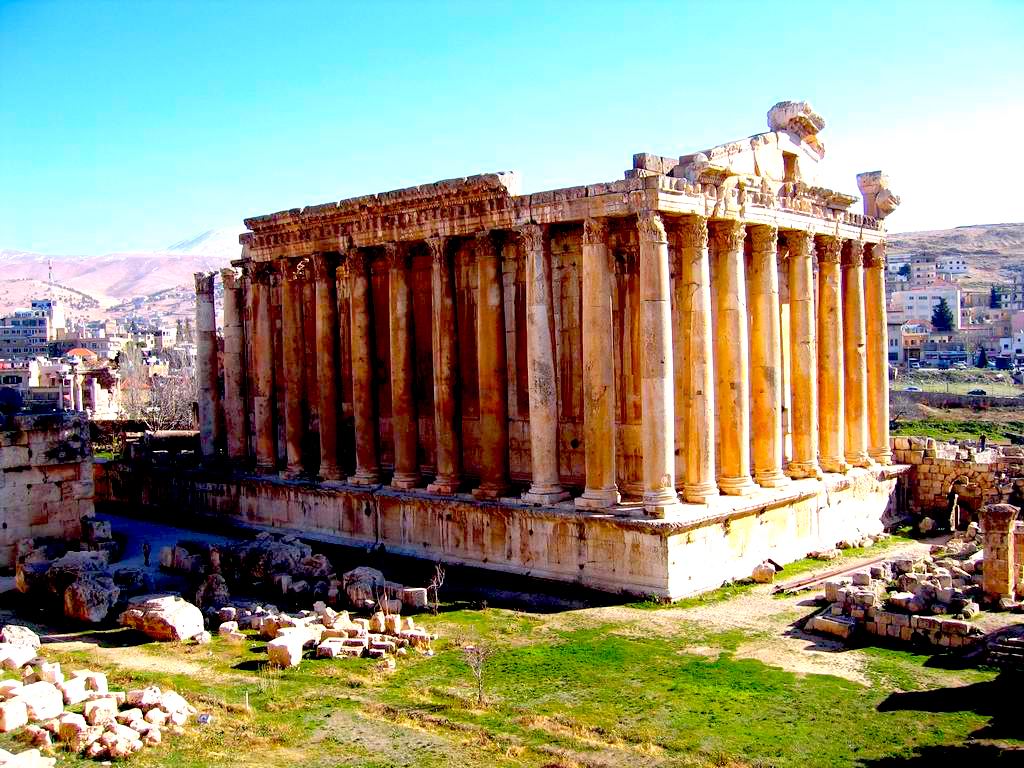
Temple of Bacchus in the Baalbek archaeological site in the Beqaa Valley region of Lebanon. (Jan Hilgers, Wikimedia Commons, CC BY-SA 3.0)
Only two days earlier, all four of us journalists had been at the site of an Israeli missile strike in Central Beirut, where the district mayor had been killed at a community centre providing aid parcels for refugees. Four other people had also been killed, and 15 seriously injured. Israel has made a point of targeting elected local leaders throughout its invasion, killing a number of mayors in the South.
I thought it ironic to see all the Western politicians repeating the Zionist line that Israeli Prime Minister Benjamin Netanyahu should not be arrested by the International Criminal Court because he is an elected leader, when Netanyahu is killing elected leaders all over Lebanon.
We were, however, told that there would be a delay, because of intense Israeli drone activity over the city. In particular there was one drone circling low right over our heads, and had been for a while. We were to proceed to the ruins and wait.
When we re-entered the vehicle, Hadi, the most light-hearted of company, became suddenly very serious:
“Sometimes the drones do miss. They really do. If they fire at us and miss, just get the door open and get as far from the vehicle as you can.”
As we drew near, the quality and the extent of the ruins was breathtaking. It is on the scale of the Forum in Rome. What has been excavated is not as extensive as Ephesus but much more is complete. Just what we could see from the road was wonderful, and then the Temple of Venus opened before us on the other side as we drove along. And Pizza Hut.
I had grown rather blasé about drones. I have had Israeli drones buzzing low overhead pretty much the entire month I have now been in Beirut, and while I know that they are missile- as well as surveillance-equipped, and highly lethal, I find it best just to ignore them. But the people with us were extremely concerned that this one had moved along with us as we drove.
It was clearly visible and they pointed out to me that we were right at the centre of its circle. My own sense of geometry rather disintegrates when I tilt my head right back and gaze at an object in a featureless sky, but I took their word for it.
They had been living with this lethal threat for months, and their lives depended on understanding it. They even could even tell various actions of the drone by the change in tone of the engines.
Contentious Archaeology
Without the mayor, we did not have permission to enter the archaeological complex, so we stood outside the gate. At some stage the atmosphere changed and it became obvious that our hosts were really, really worried. They explained that they were quite sure that the drone had focused on us, specifically. Obviously it would not be safe for the mayor to come in these circumstances.
So the meeting was cancelled.
Instead they were awaiting permission for us to look around the temple complex, but in the meantime we could do nothing but stay where we were. They felt that leaving now might provoke a missile strike. So we just stood there.
I find it hard to describe it to you. It was a lovely sunny day. The soldier inside the locked temple gate was explaining to the local authority people that he had no instructions that would allow our entry. The drone buzzed menacingly right overhead, observing us constantly.
A ginger cat came through the temple railings, and I crouched down, holding out my balled fist so she could rub her head against it. She purred and went back and forth rubbing my fist several times, before lying down to be stroked. I found myself pondering a most unlooked-for dilemma; was I putting the cat in danger by keeping it next to me? Should I chase it away?

Ginger cat from the Temple of Bacchus, Lebanon, Nov. 25. (Niels Ladefoged via craigmurray.org.uk)
The surreal nature of life endured in Baalbek became more evident as two men in donkey jackets strolled by smoking, saying their salaams as they came by, without a hint of concern for the drone above us. Vehicles went up and down the road slowly, as though nothing were wrong.
Then three boys arrived, about 8 years old, one on a bicycle. They thought it great fun to see strangers in town in current times and they came up to us and asked lots of questions in Arabic. One showed us tricks on the bike. Strangely, he was wearing a Welsh Rugby Union hoodie. I was acutely aware that the presence of the boys would not in any way deter the Israelis from striking; they would probably enjoy killing them.
I felt a huge anger that this threat is being constantly visited on children by Israel. Almost certainly these children would know some of the 60 people killed the day before. Yet there they were, exactly as friendly and cheeky as children ought to be.
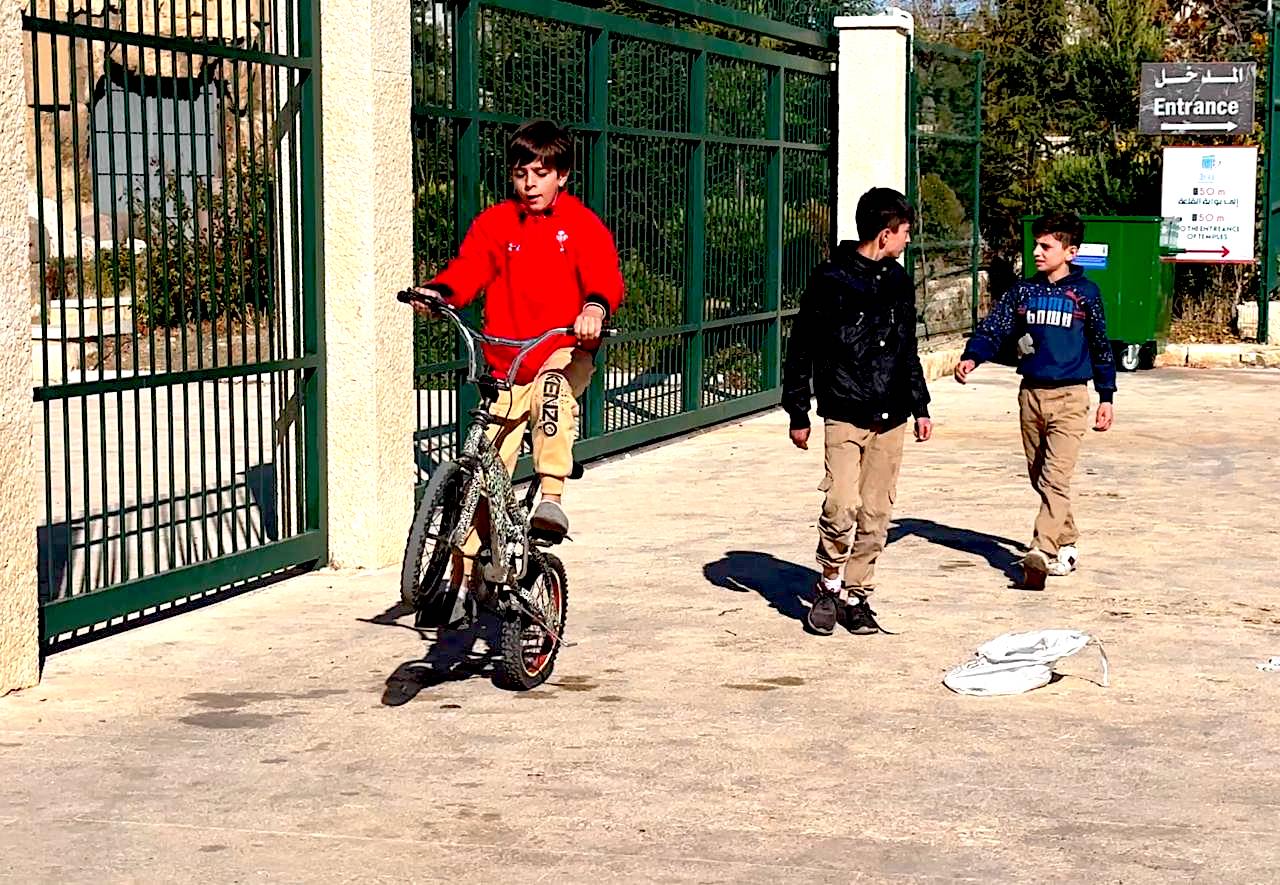
Boys in Baalbek, Lebanon, during Israeli attacks on the region, Nov. 22. (Niels Ladefoged via craigmurray.org.uk)
Eventually, the gates were opened and we were allowed in to the temple complex. It is an incredible place and should be much more widely known; it deserves to be as famous as the Pyramids or Petra.
Originally the temple of the Canaanite God Baal and his consort Astarte, successive Phoenician, Greek and Roman temple complexes were built, with most of the current buildings being Roman, but constructed on the foundations of the original.
And those foundations are astonishing. The largest blocks of stone I have ever seen used for construction, with some of them weighing 500 tonnes. By comparison, the largest stones in the Pyramids are 80 tonnes and the largest at Stonehenge 50 tonnes. The transport and construction theories for those monuments just can’t be scaled up to 500-tonnes.
Once you tear your gaze around from the Canaanite foundations, the Roman superstructure is intoxicating. It is massive, and there is a finesse and delicacy to the carving not characteristic of Roman work.
Baalbek was conquered by Alexander and he renamed it Heliopolis, its name throughout the Classical era.

Murray and Marouf in the Temple of Bacchus, Lebanon, Nov. 22. (Niels Ladefoged via craigmurray.org.uk)
Archaeology is contentious in the Middle East. Two days before our visit, an Israeli archaeologist had been killed by Hezbollah in Southern Lebanon. At least, that was the media framing. The truth is somewhat more complex.
Zeev Erlich was, despite being in his 70s, armed and in full military uniform. A retired major in the Israeli Defence Force reserve, Erlich was with a group of soldiers when killed. A sergeant was killed alongside him and a general wounded.
The Israeli army brought an archaeologist along on its invasion of Southern Lebanon to look for evidence of ancient Hebrew occupation — to justify annexation. At the time of his death he was at the site of the shrine of the Prophet Shamoun Al-Safa, who Christians know as Simon Peter, the first pope. Very few Christians realise he features positively in the Koran.
It is a reflection of the madness of Zionist ideology that an armed invasion is accompanied by archaeologists to justify it. It is highly probable that thousands of years ago there were Hebrews in Southern Lebanon. The idea that this justifies annexation is so lunatic I find it hard to describe.
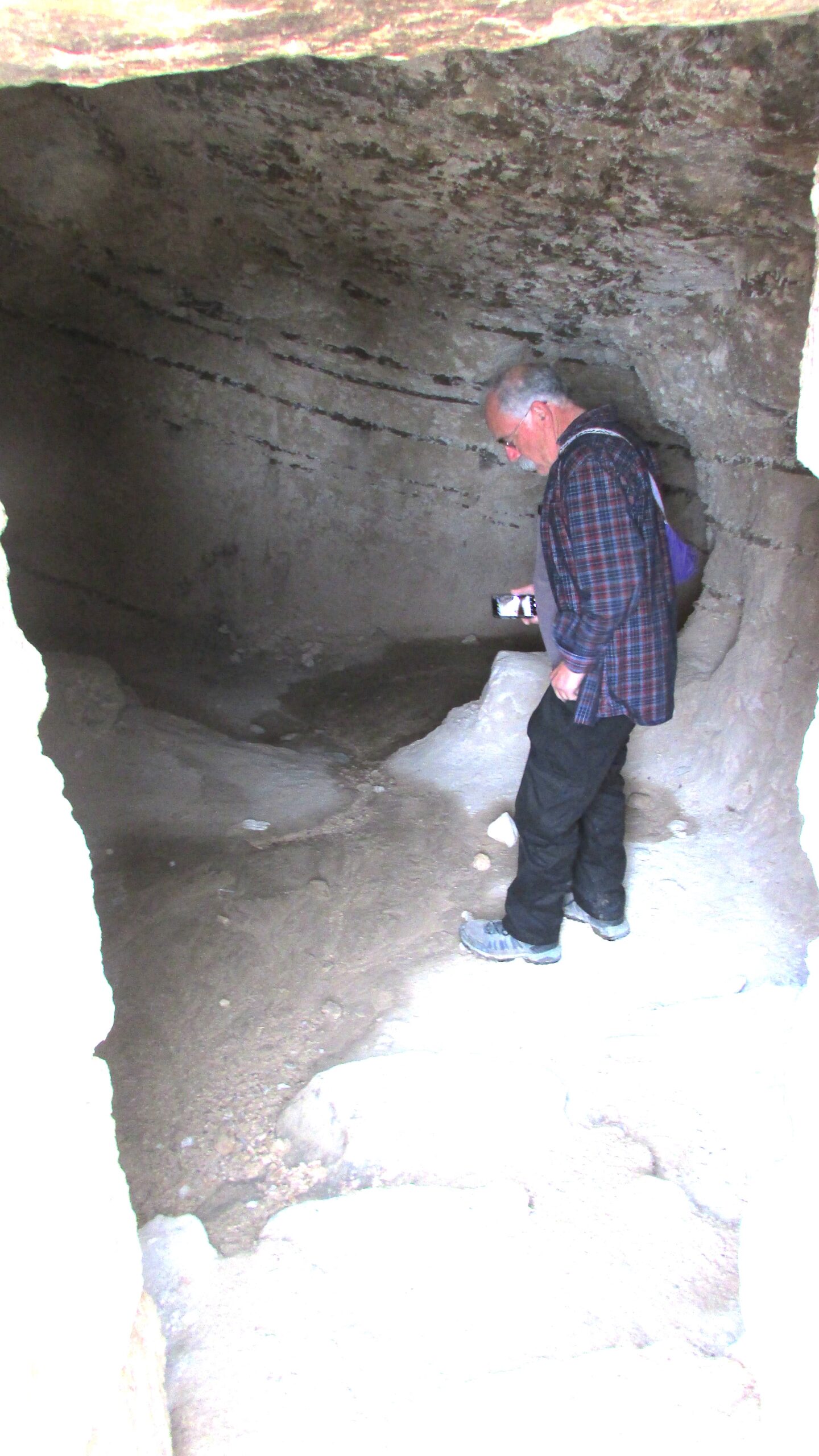
Zeev Erlich in a cave at the bottom of Fortress of Machaerus in Jordan, March 2019. (Jacob, Wikimedia Commons, CC BY-SA 4.0)
In the same time period, Switzerland was occupied by the Celts. This is not in academic dispute; the La Tène culture is one of a number of Celtic cultures that were established in Switzerland in the Classical period.
Eventually the Celtic people and their culture moved on, as peoples do over millennia. Such migrations had push and pull factors, but broadly the arrival of more aggressive and militarily capable peoples from the East was a main cause.
But if I said to you “I am a Celt” and demanded the right to move to Geneva, take somebody’s house and throw them onto the street today, you would think I am a complete lunatic. Nobody would accept a Scots or Irish claim to land in Switzerland. And rightly so.
Yet that really is the premise of Zionism. And astonishingly, U.K. Prime Minister Keir Starmer, U.S. President Joe Biden, U.K. Foreign Secretary David Lammy, U.S. President-elect Donald Trump, European Commission President Ursula von der Leyen, and most of the population of states like Germany and the USA, actually subscribe to this utterly ludicrous, mystical, medievalist nonsense.
So we have fake archaeologists travelling with invading Israeli armies. I do try to avoid comparing Israelis to Nazis because of the Holocaust, but the comparison is compelling. The Nazis loved to justify their crackpot racial theories with fake archaeology, as parodied in the Indiana Jones series.
Zeev Erlich was indeed a dangerous crackpot. He was a founder of the illegal West Bank settlement of Ofra and he wrote numerous articles arguing that the area was historically Jewish and supporting annexation. He led IDF raids on Palestinian communities, or as one of his friends told it to Israeli internet outlet ynet: “He volunteered and assisted soldiers across various sectors, showing his unmatched knowledge of villages and farms.”
As we left the temple complex, the drone still overhead, we stopped and looked at the completely flattened Manshiyeh Palace, home to the Ottoman governor, that had been destroyed by Israeli bombing.
It stands close to some of the Classical ruins which had been damaged by fragments. There was no justification for destroying this museum other than the obliteration of history and cultural heritage.
We then proceeded on to two civilian houses that had been destroyed. Two people were killed and 12 seriously injured. This was quite a drive away, but the drone followed us and again circled right overhead. I looked through the detritus of the buildings; Laith was very insistent I climb to the top of the rubble, which was frankly very precarious. Coming down was even worse. But close inspection revealed nothing at all but the contents of a normal civilian family home with children.
It was also worth noting that in addition to the two destroyed homes, about 10 homes nearby had been rendered uninhabitable. A dozen vehicles had been destroyed; some of them — 50 or 60 metres from the site — appeared to have had their paint burnt off by great splashes of some kind of burning or caustic liquid from the explosion.
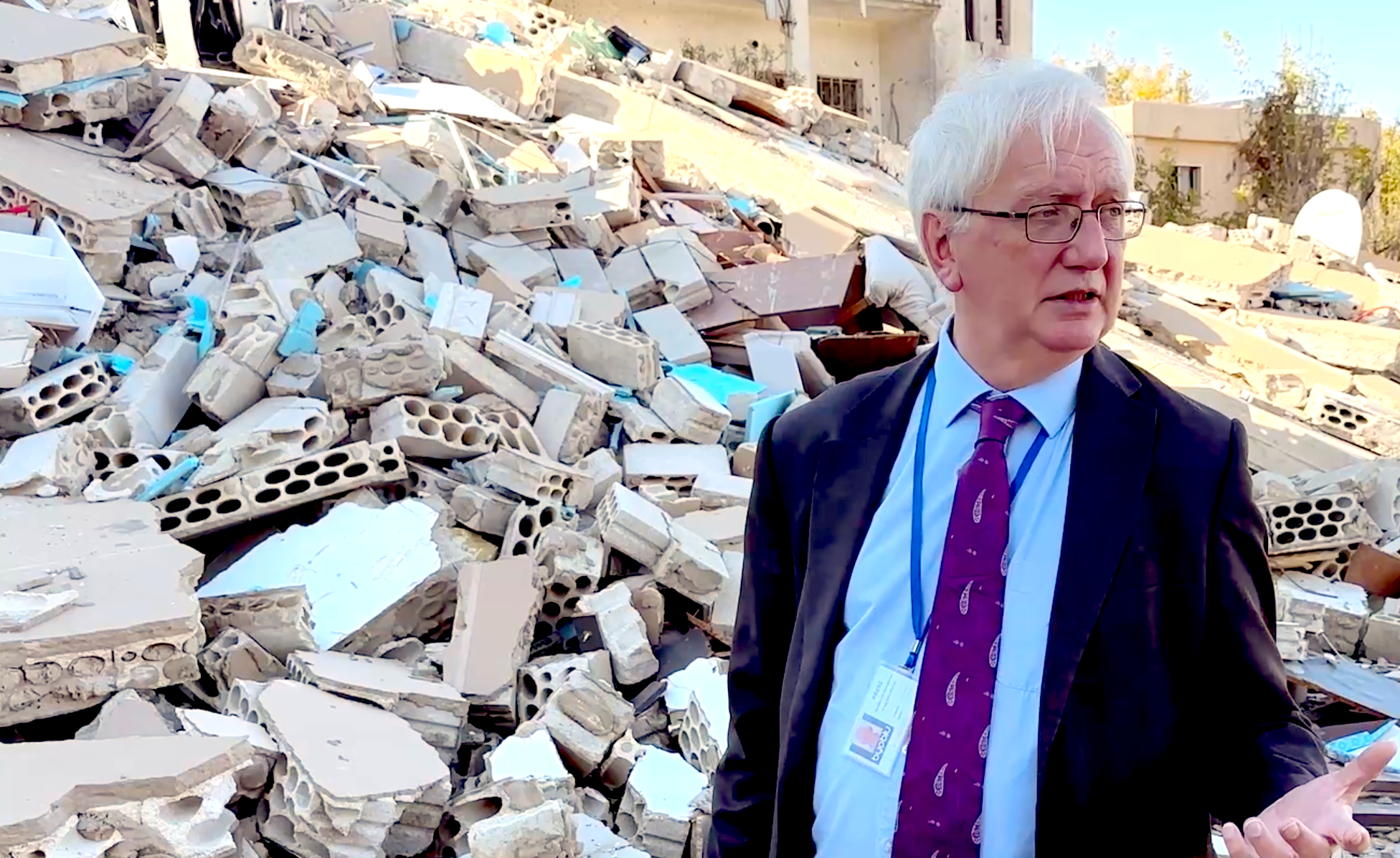
Murray in rubble in Baalbek, Lebanon, Nov. 22. (Niels Ladefoged via craigmurray.org.uk)
Death in the Bekaa Valley is sudden, random and frequent. There are no warnings at all here that Israel is about to bomb and the targets are always civilian homes. Since we have left the director of the hospital has been killed in his home.
The Israelis claim that all the targets are Hezbollah. Hezbollah is the ruling party here, so they take that to mean any government employee can be targeted. This is of course not the case in international law, and this terror inflicted on a helpless civilian population is a war crime. Many victims appear to be entirely random.
Missiles have never been fired at Israel from within the town of Baalbek.
We then received information that fresh bombing attacks were believed to be imminent; F-35s had been seen and we were ordered to get out as quickly as possible, which we did.
It was an unexpected and then truncated time in the Bekaa Valley, and as darkness fell we were pleased to be driving back to Beirut all still alive and well. My overwhelming reflection is that any fear or pressure we experienced is felt by those in Baalbek every single day.
I recall the thoughts I had about the safety of the cat, and wondered how mothers felt, who were making decisions on where their children go from moment to moment which may kill them, in the lottery of death the Israelis have inflicted on the Bekaa Valley.
Well that was an interesting excursion. I look forward to our next tour.
Craig Murray is an author, broadcaster and human rights activist. He was British ambassador to Uzbekistan from August 2002 to October 2004 and rector of the University of Dundee from 2007 to 2010. His coverage is entirely dependent on reader support. Subscriptions to keep this blog going are gratefully received.
Subscriptions to keep this blog going are gratefully received. Because some people wish an alternative to PayPal, I have set up new methods of payment including a GoFundMe appeal and a Patreon account.
This article is from CraigMurray.org.uk.
The views expressed are solely those of the author and may or may not reflect those of Consortium News.
CONSORTIUM NEWS

No comments:
Post a Comment
Note: Only a member of this blog may post a comment.